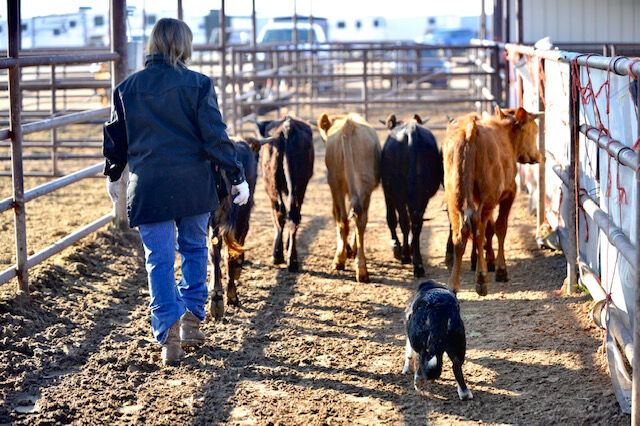Ranching may be full of new technology these days, but working dogs fill roles in many operations that cannot be accomplished by any microchip or data processor. From guarding flocks of sheep and goats to moving a herd of cattle on down the road, working dogs are valuable tools for ranchers from coast to coast.
Guard your goats
Across the country the popularity of goats has risen in recent years and so has the need to protect them. Predators such as coyotes and wolves can decimate an unguarded goat herd.
The most successful livestock guard dog is the Pyrenean Mountain Dog, better known as a Great Pyrenees in the United States. According to the American Kennel Club website at www.akc.org/expert-advice/lifestyle/9-facts-great-pyrenees/GPs, GPs were bred to guard livestock in the Pyrenees Mountains of Europe and fossils found of the breed have been dated between 1800 and 1000 B.C.
When the Marquis de Lafayette brought the first GPs to North America in 1824, the GPs’ talents translated easily to the rugged terrain of raising sheep and goats. They were bred to be nocturnal so they could guard flocks at night while shepherds were sleeping.
Almost 200 years later, GPs are still being bred in Europe and the U.S. Amber Waves Great Pyrenees, owned and operated by Debbie and Jim Hosley of Norco, California, has imported a male and a female GP from Hungary. Their dogs are currently serving customers as certified therapy dogs, service dogs, show dogs and family pets, but many of them are honoring their heritage as livestock guard dogs.
While GPs have a strong instinct for guarding there are times when some training is necessary. When that happens, the Hosleys leave that up to the pup’s mom.
Their puppies are born in the house and eventually they are let out into a pen with the goats and their mom.
“That way Mom can sort of straighten them out as far as what to do and what not to do,” Debbie said. She said this training method has worked well for them.
“You don’t want them to chase the animals they’re guarding or chew on them,” Debbie said. “You want to discourage that type of behavior.”
She says GPs generally like to patrol the perimeter of the pen but “if they can, they like to lay up higher so they can watch what’s going on.”
When it comes to guarding the Hosleys’ goats, the female GPs will bark a warning that brings the male GPs in for support. This system remains in place depending on what side of the fence visitors are on.
Debbie says to customers looking at goats to purchase the GPs because they are friendly and like to be petted. If someone were to approach the goats from outside the fence, the GPs would bark and raise a commotion.
The average guard dog can live 10 to 12 years depending on genetics and care, according to Debbie. GP males can grow to be 32 inches tall and weigh 120 pounds, while females can be 29 inches tall and weigh 90 pounds. For more information, email [email protected]. These are sizable dogs that will intimidate all who approach from the wrong side of the fence.
Herd dogs don’t lean on the fence
Other working dogs take a more active role when it comes to livestock. Some herd dogs drive cattle down the road to a greener pasture, stopping those that try to leave the bunch. Other dogs help their owners sort cattle in a pen or even gather cattle to a corral and then drive them through working facilities.
Border Collies, Blue Heelers, Australian Shepherds, Catahoula and Hangin’ Tree Cowdogs are just a few examples of dog breeds that will keep your cattle moving in the right direction.
Laura Stimatze of Owasso, Oklahoma, has been training dogs for 34 years. She raises Border Collies but, during certain times of the year, will train any dog willing to work. Readers can find more information on Stimatze and her dog training clinics on Facebook at Laura Stimatze Working Cowdogs.
Sign up for HPJ Insights
Our weekly newsletter delivers the latest news straight to your inbox including breaking news, our exclusive columns and much more.
“[Good working dogs] aren’t just born by happenstance,” she said. “They have to have the desire to work and want to work bad enough to do it your way.”
Teaching a dog “the way” begins as soon as you can bring them home. A puppy’s desire to work ignites early. An owner can’t procrastinate on training.
“Waiting and teaching them when they’re a year old is kind of like taking a teenager that’s never had any structure and all of the sudden saying these are the rules and you’ve got to follow them,” Stimatze said.
Those rules are up to the rancher and what duties he or she expects their dog to perform. The needs of the rancher dictate the training program of the dog.
Stimatze suggests finding a breeder who raises breeds that work.
“There’s lots of them out there but there’s a whole bunch more that don’t work than do,” she said.
If the dog is bred well, Mother Nature can take over from there with a little guidance from a consistent owner.
“A good working dog should be confined or with you,” Stimatze said, “not allowed to just go chase cattle on its own.”
Working dogs are valuable tools on all types of farms and ranches. The right dog is out there and with time, patience and consistency it could be the ideal co-worker.
Jennifer Theurer can be reached at 620-227-1858 or [email protected].


